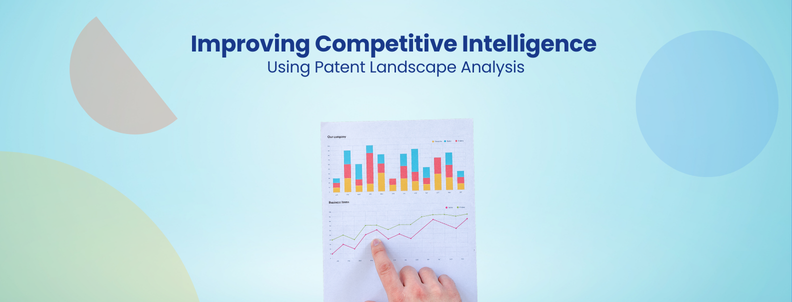Relying solely on market research and news headlines for competitive analysis will put you at a disadvantage. By the time your competitors make headlines, their strategies are already in motion. Therefore, to gain a preemptive advantage, patent analysis offers insights into your competitors’ future strategies, technological strengths, and weaknesses. Not only that, it becomes easy to predict where an industry is headed as a whole and how to ride that innovation wave.
To understand this in detail, let’s examine five key insights patent data can unlock. Eventually, businesses can utilize patent analysis in resource allocation, product development, licensing opportunities, and litigation strategy.
Unveiling Competitors’ R&D Strategies
Understanding competitors’ R&D strategies is the most important aspect of competitive analysis. Capturing patent filings, research publications, and product releases helps construct a timeline of your competitor’s technological advancements.
Analyzing patent filings provides insight into the emerging technologies companies are pursuing. It also reveals the areas they are heavily invested in and potential product pipelines, especially for patents filed for accelerated examination. Eventually, you will discern the pace and focus of competitors’ R&D activities. Such timelines reveal what innovations are occurring, when, and in what sequence, offering predictive insights into future developments.
For example, a consistent focus on patents related to a specific technology signals a strategic emphasis that could significantly impact the market. In fact, our blog “How can Technology Timeline help Accelerate research in your R&D team?” dives deeper into this concept with examples from Amazon and Alibaba.
Who your competitors are collaborating with
Patent data analysis reveals collaborations within an industry. By examining details such as co-ownership and co-inventorship in patent filings, you will gain valuable insights into potential partnerships and research collaborations between your competitors.
For instance, Intel’s collaboration with Tencent to develop AI solutions for edge computing highlights a strategic move to address latency and data processing issues. Intel’s competitors can utilize this data to pursue collaborations to stay competitive in the AI and edge-computing domain.
Technology Trend Analysis
Analyzing the technical details within patent filings helps identify applications for emerging technologies and gauge their potential impact on the industry. This analysis allows for assessing the potential for next-generation technology within your products and services. It also helps prepare for potential disruptions and strategically adapt one’s business model in light of technological advancements.
One of GreyB’s patent landscape studies on the smartwatch industry revealed a significant increase in patent filings by tech companies like Apple, Google, and Samsung around 2011. This indicated their strategic focus on developing smartwatches. Traditional watchmakers, who did not monitor these filings closely, were caught off guard by this technological shift and lagged behind in innovation.
Additionally, Samsung’s significant volume of patent filings in artificial intelligence (AI) around the 2020s highlighted the company’s focus on AI technologies. This trend indicated that AI would play a crucial role in the evolution of smartphones. Indeed, Samsung’s entry into the AI-infused smartphone market with the launch of Galaxy AI phones demonstrated how they capitalized on this technology. They enhanced user experience, offering features like advanced voice assistants, camera improvements, and personalized user interfaces.
Risk Assessment
Understanding the patent landscape helps avoid potential legal pitfalls and decide where to allocate resources. It ensures investments are made in areas with lower legal risks, protecting the company from potential lawsuits and financial losses.
Before investing heavily in new technology, identify potential “patent thickets”—areas where numerous overlapping patents exist. These thickets can make it difficult to innovate without infringing on existing patents, increasing the risk of costly litigation. This risk assessment can inform several decisions, such as:
- Development: Whether to develop a particular technology.
- Licensing: Whether to seek licensing agreements to use certain patents legally.
- Pivoting: Whether to pivot to alternative technological areas to avoid legal risks.
To exemplify, here is a case conducted by GreyB for a German technology company. The company was planning to expand into Wi-Fi and Bluetooth technologies, both known to be heavily patented areas. We conducted a comprehensive risk assessment, analyzing patent transactions, previously litigated patents, and standard-essential patents (SEPs). We identified high-risk areas and potential litigants, including non-practicing entities (NPEs) and large corporations with extensive patent portfolios.
This assessment provided the client with critical insights into the competitive landscape. It helped them understand which entities were likely to litigate and act as potential barriers to market entry and competition.
Identify the Market Gap
Leveraging patent data to identify market gaps is critical to competitive analysis. It helps uncover opportunities, reduce competition, drive growth, and enhance strategic planning. This ultimately leads to sustained competitive advantage and market leadership.
Companies can identify technologies or areas with few or no existing patents by analyzing patent filings. This analysis reveals areas/market gaps for innovation and market entry. Suppose patent data shows limited activity in a particular aspect of renewable energy. In that case, a company might focus its R&D efforts there to capitalize on an emerging market with less competition.
As a result, companies can position themselves in areas with high growth potential and low competition.
Conclusion
Don’t let your competitors keep their innovation plans a secret. The insights derived from patent analysis are irreplaceable for competitive intelligence. It will help you navigate trends, identify opportunities, and manage litigation risks effectively.
For tailored patent data-powered insights, fill out the form below and contact our experts today.
Dive into the world of patent data and unlock the key to staying ahead of the game.
Authored by: Mayank Maloo & Annie Sharma









